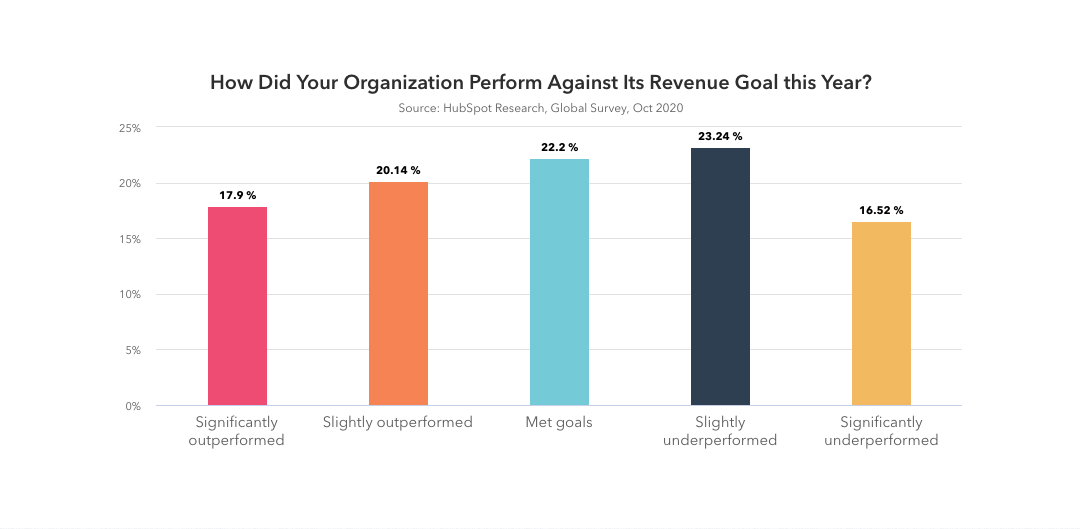Subscribe now and get the latest podcast releases delivered straight to your inbox.
HubSpot 2021 sales enablement report shows clear COVID-19 trends

Dec 9, 2020

To say that 2020 was a tough year for sales teams is a massive understatement.
As companies slashed operating budgets, closed offices, and adjusted to working from home, sales teams were asked to transform their entire sales process and embrace virtual selling. The concept of “throwing out the playbook” doesn’t even begin to cover it.
🔎 Related: 8 virtual sales call best practices you need to know
Which is why HubSpot (in partnership with LinkedIn, Sandler Training, and Gong) recently released the 2021 Sales Enablement Report — a survey of more than 500 sales leaders across eight countries to analyze how sales teams have adapted to this new virtual selling environment to hit (and in some cases exceed) revenue targets.
What we learned from the report
The top-line takeaway from the 2021 Sales Enablement Report is that 40% of businesses surveyed expect to miss revenue targets in 2020 which, given the current economic climate, is not exactly surprising.

However, the key findings also include sales enablement strategies that helped 60% of businesses surveyed meet or exceed their targets.
- The biggest “winners” were sales leaders who quickly embraced a hybrid or fully remote sales model — “64% of those who transitioned to remote sales this year met or exceeded revenue targets, compared to 50% of the leaders who did not make the transition.”
- Having a dedicated sales enablement team proved to be a critical component of success — “65% of sales leaders that outperformed against revenue targets have a dedicated sales enablement person or team.”
- Embracing automation gave the highest-performing sales a competitive edge — “61% of over-performing leaders use their CRM to automate parts of their sales process, vs. 46% of underperforming leaders.”
🔎 Related: The ultimate getting started guide for video in the sales process
What does this mean for sales teams?
The report goes on to demonstrate that 2020 has essentially created two distinct categories of sales teams — those that are ahead of the curve going into 2021 and those that are forced to play catch-up.
Sales teams who are lucky enough to find themselves in the first category are looking for new markets, new product offerings, and new services to sell to hit aggressive targets in the year to come.
🎓 Related IMPACT+ courses:
- Digital communication techniques for 1:1 sales
- Virtual sales appointment strategies that close deals faster
- Video selling strategy
Those in the second category need to regroup and reassess what mindset is needed as we enter the new year.
These underperforming teams are focused on getting the right technology stack in place, updating processes with a virtual-first approach, and redefining what sales enablement looks like at their organizations. The right technology might mean adopting a new CRM that is intuitive and easy to use and leveraging that CRM to make data-driven decisions.
🎓 Free IMPACT+ course: Getting started with sales technology
By focusing on a virtual-first approach, sales teams need to define a video selling strategy and find new ways to connect with potential customers via virtual channels (i.e. video sales calls or conversational marketing).
Finally, investing in sales enablement means going beyond creating new sales PDFs or writing cold outreach email templates. To successfully enable your sales team to hit their targets, someone needs to own the process end-to-end to ensure that the right tools are supported with the right overarching strategy.
The bottom line
As sales leaders look ahead to 2021, they need to make honest assessments of where they stand — are they ahead of the curve or struggling to catch up to competition?
🔎 Related: 6 mistakes you can't afford to make on a video sales call
For better or worse, virtual selling and our video-first world are here to stay. Sales leaders can no longer afford to “ride out the storm” and wait for a return to the good old days. It’s time to adapt to the change, or continue to fall further and further behind the competition.


Order Your Copy of Marcus Sheridan's New Book — Endless Customers!